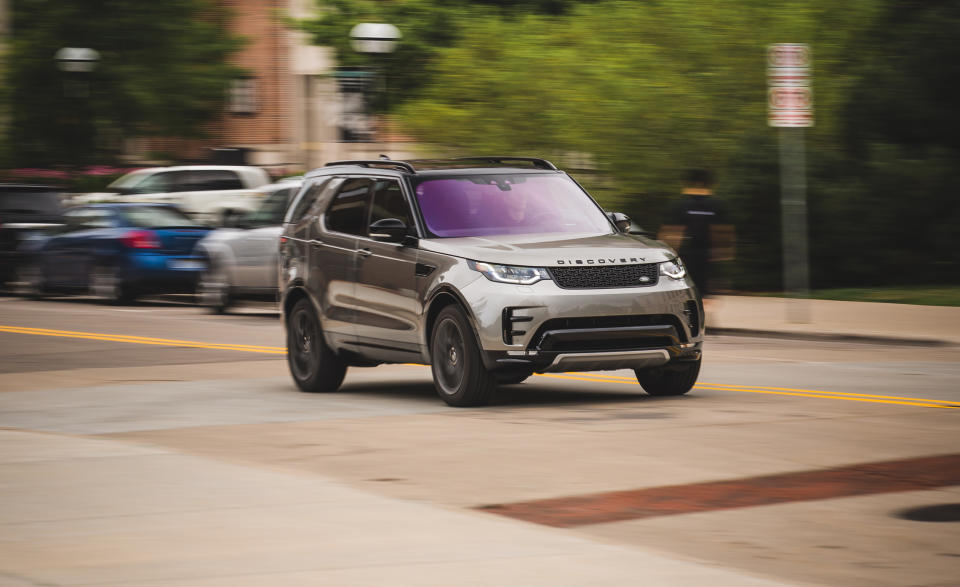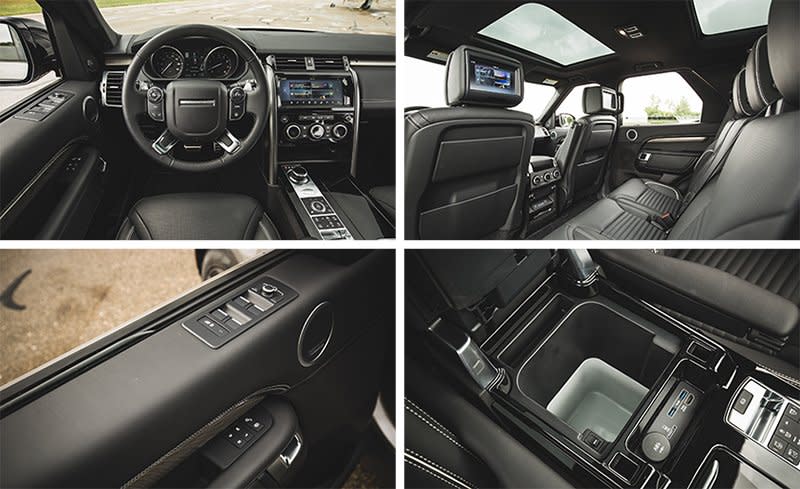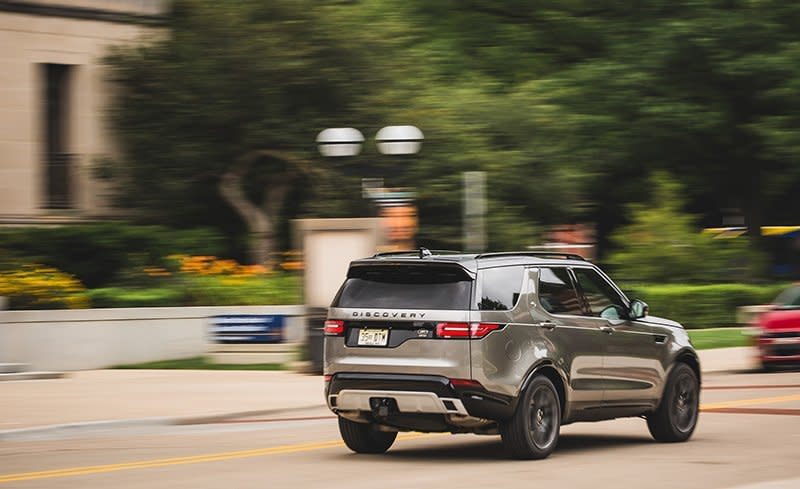2017 Land Rover Discovery V-6

Younger shoppers could be forgiven for associating the name Land Rover with NASA’s space-exploration vehicles, such as the robotic Mars rovers. In some ways, that would be a better fit for the brand’s adventurous marketing themes than the reality of the name’s origin: a now long-defunct British automaker, Rover, which opened a sideline business shortly after World War II building an agricultural tool inspired by the original Jeep.
The new Land Rover Discovery is, in character, comportment, and actual hardware, a major departure from those origins and instead an heir to the brand’s upscale Range Rover model. This new Discovery resembles the Range Rover much more than it does the original Land Rover or even the first four generations of the Discovery model (the first two were sold here under that name, but the next two were called the LR3 and LR4 because, um, just because).

This fifth-gen Discovery is built on the same aluminum-intensive architecture that underpins the Range Rover and the Range Rover Sport. That makes it lighter and a little better suited to the commuter wars fought by Americans who live far enough out of town that there are no sidewalks and their yards aren’t fenced. It’s also clearly designed for such fashion-sensitive exurbanites, whereas the square-cut LR4 sought to evoke the flavor of the original, in which styling was a tertiary consideration at best. The upshot is that, especially in the top HSE Luxury trim level of our test example, the new Discovery slots right in behind the Range Rover, as that brand moves ever further upmarket.
The Modern Major Motorcar
What it looks like is important to today’s SUV consumers, and what the Discovery looks like to our eyes is a Ford Explorer that has had a Brazilian butt lift. Ford unabashedly cribbed Range Rover styling themes for its latest Explorer, so who’s stealing what from whom makes for interesting chatter over a glass of chardonnay but doesn’t much matter otherwise. Part of the resemblance traces to the slanted C-pillar, a departure from Land Rover’s past practice but utterly mainstream among today’s SUVs. The Discovery makes a concerted effort to conceal the rearmost D-post and create the appearance that the roof is cantilevered over the liftgate, and this works especially well with a contrasting roof color, such as the black one on our Silicon Silver example. It all looks so of the moment that we wonder if it won’t scream 2017 before the buyer has paid off a six-year note.
Inside, this Discovery lived up to its HSE Luxury labeling with lots of leather slathered over all three rows of seating (the rearmost is optional on lesser trim levels but standard here), power assist for nearly everything imaginable, and even a sizable cooler compartment in the front center console. That cooler came among some $18,000 worth of optional equipment that raised this Disco’s $64,945 base price for this trim level to a Range Rover–like $82,800. The $4350 Dynamic package does nothing for the dynamics but does include a lot of appearance enhancements. More significant were the $2350 Drive Pro package that brings a host of modern electronic driving aids (a hyperactive lane-keeping assist, adaptive cruise control, and more) and the $1250 Capability package that brought electronically controlled systems for managing traction in various off-road environs, including an automatic locking rear differential. There were many other add-ons, some of which just look like indulgences, but choosing to shop at the Land Rover store is much like pushing your grocery cart around at Whole Foods rather than Aldi—you know there are cheaper ways to go, but that’s not your aim.

Since we’ve already tested the Td6 diesel model, the item of most interest on this Discovery was its supercharged 3.0-liter V-6 and eight-speed automatic transmission. It’s a familiar powertrain that’s used in several other JLR products, including our long-term Jaguar XE. This six has a 90-degree angle between cylinder banks because it’s derived from a V-8, and it’s rated at 340 horsepower and 332 lb-ft of torque. That power is delivered with a coarse graininess and an unappealing groan, although the sounds are more subdued and remote than they are in our Jaguar.
Cue the laments if you’re the sort that bemoans the passing of lazy V-8s, especially because this smaller six still doesn’t deliver great fuel economy. We recorded 16 mpg over a couple weeks of mixed use, 2 mpg short of the EPA’s combined rating and only 1 mpg better than what we got from its LR4 predecessor in 2011, back when it was V-8 powered and weighed more than 5750 pounds.
Numbers, Please
This test car weighed 5498 pounds, a considerable mass but a significant reduction over the last LR4 we had on our scales, which spun the dial to 5941. Credit the aluminum structure for it shedding 443 pounds; that figure falls well short of the 830-pound savings Land Rover claimed for its new Disco. But that claim was for “similarly equipped” vehicles, and our fully loaded example had some features that the LR4 never offered. What the LR4 did have in its later years was the same drivetrain featured here, so the payoff for the diet is directly comparable, not only as 1 mpg but as a 0.4-second improvement in the zero-to-60-mph time. This one did it in 6.3 seconds on the way to a quarter-mile in 14.9 seconds at 95 mph. Compared with the Td6 diesel Discovery, the gas model is 1.7 seconds quicker to 60 mph and completes the quarter-mile 1.2 seconds ahead. Perhaps more telling is that this Disco needed only 4.5 seconds to accelerate from 50 to 70 mph where the diesel wanted 5.8. This matters both in the cut and thrust of commuting as well as in long-distance travel over two-lane roads cluttered with motorhomes and farm trucks.

The argument we made for the diesel as the serious off-roader’s choice still stands, though, and the diesel’s 10-mpg advantage in our observed fuel-economy test will also extend your range if you’re looking at the Discovery as a towing and hauling vehicle—this example had the towing package rated to pull up to 8200 pounds. If you’re more interested in loading it with stuff, know that the space behind the third row is a small 9 cubic feet, although it expands to a class-competitive 40 cubes when you power the rearmost seats down flat. The second row also powers forward to allow 85 cubic feet with two occupants.
Nimble Is a Relative Term
This new Discovery departs from its agricultural heritage most vividly in its driving character. The electronically managed air-spring suspension standard on the HSE Luxury has much better control over squat, dive, and roll than did the LR4’s setup, which could give one the sensation of sitting atop a medicine ball. We measured skidpad grip at 0.74 g, far better than the LR4’s meager 0.65 g, but the greater gain is in the subjective elements of responsiveness and control.
That said, Land Rover remains more willing than most competitors to sacrifice highway handling manners in favor of off-road ability—the Discovery’s 11.1 inches of ground clearance leaves the driver with more of the tall-and-tippy-SUV sensation than you’d get in, say, a BMW X5, which claims to clear only 8.1 inches. Similarly, there’s an off-road-friendly dead zone at the center of the steering, which can require more corrections at highway speed, but this slop is smaller than before and the steering is otherwise predictable and relatively quick.

With less mass to deal with, we had hopes for an improvement in braking performance, but this Discovery needed 186 feet to stop from 70 mph, 12 feet longer than the LR4 took. It was only one foot better than the Td6, though, so this would appear to be the new normal (for the record, the gas Discovery was on Pirelli Scorpion Verde All-Season tires, size 275/45R-21, whereas the diesel had 255/55R-20 Goodyear Eagle F1 All-Terrain SUV rubber). We noted moderate fade after repeated braking tests, again similar to what we saw with the diesel version, but there’s less nose dive and a more progressive feel to the pedal than in the LR4.
Marketing pitches for the Range Rover—when it finally arrived in the United States in the late 1980s—conveyed the then novel idea that “roughing it” was unnecessary. Just take all the comforts of home into the outback, along with your linen napkins and your crystal wine goblets! That’s a message the new Discovery embraces, along with the unspoken inference that such a vehicle also might serve you well upon the arrival of whichever coming apocalypse you fear most.
Specifications >
VEHICLE TYPE: front-engine, all-wheel-drive, 7-passenger, 4-door hatchback
PRICE AS TESTED: $82,800 (base price: $50,985)
ENGINE TYPE: supercharged and intercooled DOHC 24-valve V-6, aluminum block and heads, direct fuel injection
Displacement: 183 cu in, 2995 cc
Power: 340 hp @ 6500 rpm
Torque: 332 lb-ft @ 3500 rpm
TRANSMISSION: 8-speed automatic with manual shifting mode
DIMENSIONS:
Wheelbase: 115.1 in
Length: 195.7 in
Width: 81.6 in Height: 72.7 in
Passenger volume: 138 cu ft
Cargo volume: 9 cu ft
Curb weight: 5498 lb
C/D TEST RESULTS:
Zero to 60 mph: 6.3 sec
Zero to 100 mph: 16.4 sec
Zero to 130 mph: 36.7 sec
Rolling start, 5–60 mph: 6.9 sec
Top gear, 30–50 mph: 3.4 sec
Top gear, 50–70 mph: 4.5 sec
Standing ¼-mile: 14.9 sec @ 95 mph
Top speed (governor limited, mfr’s claim): 133 mph
Braking, 70–0 mph: 186 ft
Roadholding, 300-ft-dia skidpad*: 0.74 g
FUEL ECONOMY:
EPA combined/city/highway: 18/16/21 mpg
C/D observed: 16 mpg
*stability-control-inhibited

 Yahoo Finance
Yahoo Finance 